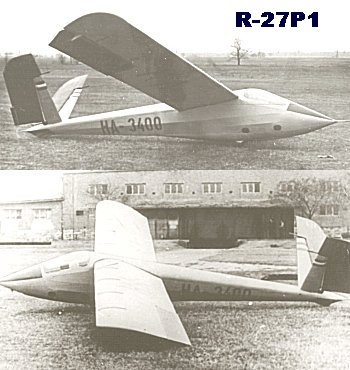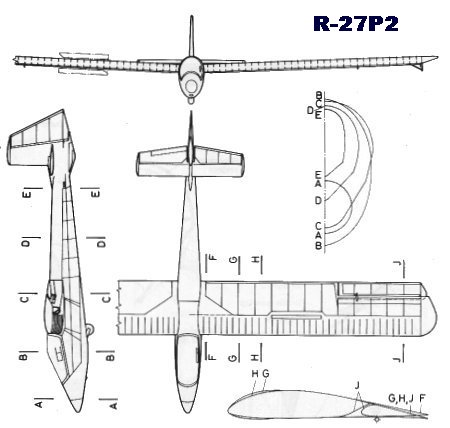HUNGARIAN
GLIDERS
1933-2000

Short history:
In 1958 the MHS, the central organization controlling all flying sports in Hungary, placed an order with the Esztergom Facility of Pest Area Machine Factory (PGE) (formerly Sportárutermelő V., Esztergom) to design and produce a two-seater glider for basic instruction, a single-seat training and a single-seat standard-class performance glider. The specification called for all-light-metal structures, easy and common maintenance characteristics as well as similar flight characteristics. The concept of the three gliders was based on the - design, production as well as operational - experiences gained with the R-23 Gébics. The design work aimed for as much common assemblies and parts as possible, and for common production technology.
The first design, the standard class glider got he designation of R-25 and the name of "Mokány" (a person, who has plenty of guts).
The second design was the two-seater for basic instruction which production version got the designation of R-26s and the name of "Góbé" (nickname for a Hungarian from Eastern Transylvania).
The third design was the training glider, which got the designation of R-27 and the name "Kópé" (mischief-maker). The aim of its development was to create a glider, which is suitable for first solo flights and further training of students, who had completed basic instruction on the two-seater Góbé. Two versions were designed and produced. The first was the R-27 P1 and the second the R-27 P2. The R-27 P1 first flew at March 7, 1962, and the P2 version first flew at December 16, 1963.
The Aircraft Department of the Technical University of Budapest performed performance measurement tests on both versions after production and CAA acceptance test flights had been completed. However the fate of this third design was sealed by the success of the R-26s Góbé. The operational experiences had gained by the his third design was sealed by the success of the shown that the two-seater Góbé is suitable for solo training flights as well. The MHS dropped the development project of R-27 glider.
Both versions were certified for spins and cloud flying up to 115 km/h speed. Aerobatics was not permitted.
Structure: All-metal
Wing:
The structures of both versions of the R-27 Kópé were similar to those of other members of the all-metal glider family of Rubik.
The Kópé had a 12 m span version of the Góbé's wing. The rectangular planform wing had rounded wingtips, which were protected by rounded skids made of steel tubes. Both versions had Göppingen type airbrakes working on both surfaces of the wing. Gö 549 airfoil was used modified by Rubik's corrugated light-metal skin in front of the main spar. The other parts of the wing were fabric covered. The ailerons' leading edges were of Frise-type.
Fuselage:
The front part of the P1 version's fuselage was similar to that of the R-27 Mokány, however the rear part was different, its form was traditional. The front part of the P2 version's fuselage was modified compared to that of the Mokány. A bubble canopy was used. The rear part was similar to that of the P1 version. The landing gear of both versions consisted of a spring suspended fixed wheel positioned in front of the c.g. of the empty glider, and a small wooden tail-skid.
Tail unit:
The P1 version had V tail surfaces, which were divided into stabilizers and control surfaces. The P2 version had a traditional tail unit arrangement.

| Dimensions: R-27 P2 |
| Wing: |
| Span, m: |
12 |
| Area, m2: |
14 |
| Aspect ratio: |
10,3 |
| Chord (root), m: |
1,3 |
| Chord (tip), m: |
1,3 |
| Airfoil (root), m: |
Gö 549 mod. |
| Airfoil (mid-span), m: |
Gö 549 mod. |
| Airfoil (tip), m: |
Gö 549 mod. |
| Dihedral, degree: |
3 |
| Sweep, degree: |
0 |
| Washout: |
None |
| Aileron: |
| Span, m: |
2,16 |
| Mean chord, m: |
0,441 |
| Total area, m2: |
1,9 |
| Balancing: |
Aerodynamic and mass |
| Flap: |
| Type: |
None |
| Airbrakes: |
| Type: |
DFS |
| Position (upside/downside): |
u/d |
| Total area, m2: |
0,46 |
| Position, % of chord: |
0,362 |
| Horizontal stabilizer: |
| Span, m: |
2,6 |
| Area, m2: |
1,67 |
| Elevator: |
| Span, m: |
2,6 |
| Area, m2: |
0,864 |
| Airfoil: |
Symmetric |
| Balancing: |
Aerodynamic |
| Trim: |
Yes |
| Vertical stabilizer and rudder: |
| Total area, m2: |
1,87 |
| Rudder area, m2: |
0,84 |
| Balancing: |
Aerodynamic |
| Fuselage: |
| Length, m: |
7,4 |
| Width, m: |
0,64 |
| Height: |
0,96 |
| Cross section, m2: |
0,55 |
| Landing gear: |
| Type: |
Fixed wheel with spring suspension |
| Wheel diameter, m: |
0,26 |
| Masses: |
| Wing, kg: |
? |
| Fuselage, kg: |
? |
| Tail unit, kg: |
? |
| Empty glider, kg: |
190 |
| Gross, kg: |
300 |
| Ballast, kg: |
None |
| Wing loading, kg/m2: |
21,4 |
| Speeds: |
| VNE, km/h: |
195 |
| Max. speed with open airbrakes, km/h: |
195 |
| Max. aerotow speed, km/h: |
110 |
| Max. winch speed, km/h: |
100 |
| Max. speed in rough air, km/h: |
110 |
| Stall speed, km/h: |
? |
| Performance: |
| Min. sink, m/s (at gliding speed, km/h): |
1,0/? |
| Best L/D (at gliding speed, km/h): |
22/? |
| Start methods: |
Winch, Aerotow |

Origin of data and 3-view drawing:
Jereb Gábor: Magyar vitorlázó repülőgépek, Műszaki Könyvkiadó, 1988, Budapest
(Gábor JEREB: Hungarian Gliders, Technical Publishing House, 1988, Budapest)
Gábor FEKECS E-mail: fekecs.gabor@t-online.hu

